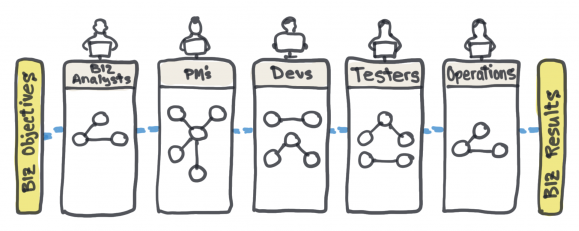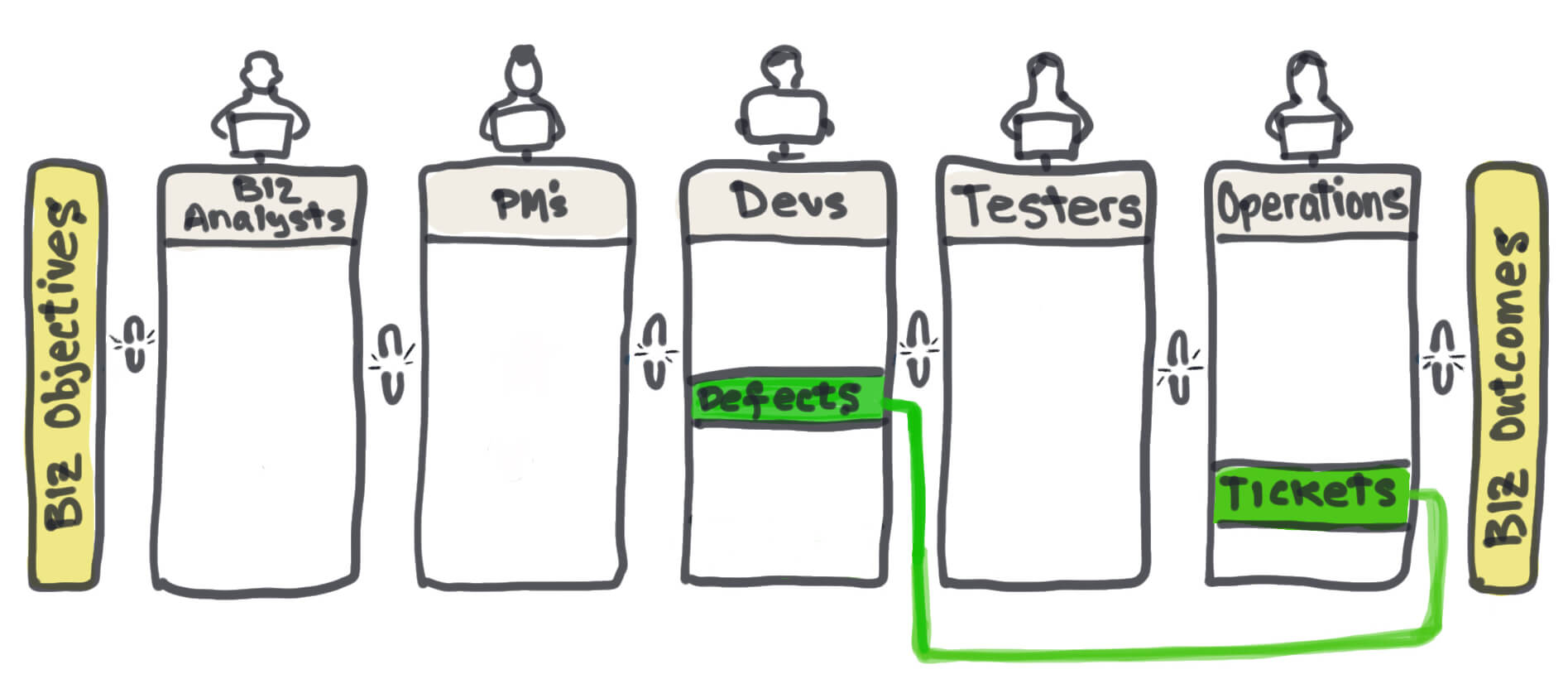How much time do you spend chasing down data that's spread across multiple systems? Not only do organizational silos waste time, but measuring performance is a challenge when the work is disconnected. To reveal the elusive big picture, you need to connect the links across the DevOps value stream.
High-severity incidents that customers report to your service desk need to be escalated quickly. If escalations occur manually, as they often do, details that development teams need are inefficiently duplicated as data is added by developers to their work intake system. This disconnect between the service desk and development can delay progress in fixing severity-1 incidents.
Figure 1: The value stream runs from business objectives to results. Along the way there are multiple points for disconnects between different teams.In "Project to Product: How Value Stream Networks will Transform IT and Business," Mik Kersten said, "As long as a dev tool like Jira is not connected to a service desk tool ... the corresponding lack of flow and feedback between those two systems creates an information bottleneck."
Feedback is a key principle underpinning DevOps. Rapid feedback allows IT specialists to detect and remediate problems while they are smaller, cheaper, and easier to fix, and to avert problems before they become a catastrophe. That's no surprise, since higher-quality work occurs when information flows smoothly and visibly throughout the value stream.
Here's how to defrag your DevOps value stream.
Connect the dots
Large IT enterprises are lousy at connecting the dots because they are largely disconnected. Hence the need for making connectivity visible. The connectivity points between the flow of trouble tickets and defects are two key handoffs to pay attention to when working to reduce overhead from coordination costs.
Fix help desk incident escalation
When a customer calls the help desk to report an issue, the tech engineer (hopefully) logs the issue into the help desk application. When that issue is triaged, it may be escalated to an incident, or a "problem," that requires help from development.
To ensure rapid communication between help desk engineers and application (or product) developers, first identify where the connection points exist. Companies tend to overlook the point-to point connection locations. These handoffs can occur between or among business analysts, project managers, developers, testers, and operations staff.
If the tools used to manage the help desk are different from the tools used to manage development, take note of how and where communication and handoffs occur between affected teams.
If a work item of type "problem" at the help desk results in a work item of type "defect" in development, find a way to make that visible.
Figure 2: Making connections visible between different tool sets. It's vital to have a connected handoff between the different systems used by the help desk and development teams.
Update the help desk with known-defect statuses
When a new release of an application is deployed to production with known defects, it would be really nice if help desk engineers knew about them. Nothing like being told, "Oh, that's a known defect," after spending an hour to triage a customer-identified incident.
The help desk must be made aware of these kinds of defects. Often, the notification from development to the help desk of the existence of these known problems is done verbally—in the form of, "Oh, by the way …" Surprise!
Similar to the incident-escalation communication from the help desk to development, the known-defect status update from development to the help desk should be identified and made visible. If defects in the dev-tracking system can be mirrored in the help desk app, updates are bidirectionally synchronized, with many advantages resulting.
[ See more: DevOps Enterprise Summit 2018 Las Vegas ]
Benefits of a connected value stream
Fixing the connection points benefits companies in the following ways:
It creates a traceable record of the knowledge work as it flows through the value stream, to view and measure performance and detect bottlenecks.
It improves productivity by giving specialists the information they need, when they need it, in the system that works best for them.
It reduces disruptions when integrating mergers, acquisitions, or reorganizations.
It provides the agility to experiment with new tools.
Go with the flow
Disconnects across the software delivery value stream result in risky handoffs of information to other teams. For enterprise IT organizations that rely on multiple vendor-provided, in-house, and open-source tools, any disconnects in the flow of work across the value stream prevent automated flow and feedback.
To improve alignment and performance across the value stream, look at connectivity to optimize your software delivery.
Once connections are made visible, identify the tool set and work-item types on both sides of the handoff point and integrate the connection points to allow comments, status changes, and attachments to flow between them.
For more on how to deal with the challenges of specialization and complexity, see my presentation at the DevOps Enterprise Summit in Las Vegas, Nevada, where I will discuss connectivity points between the project management office, product management, and software development and testing. The summit runs from October 22 to October 24, 2018. TechBeacon readers can get $300 off registration by using code DEVOPS300.
Keep learning
Take a deep dive into the state of quality with TechBeacon's Guide. Plus: Download the free World Quality Report 2022-23.
Put performance engineering into practice with these top 10 performance engineering techniques that work.
Find to tools you need with TechBeacon's Buyer's Guide for Selecting Software Test Automation Tools.
Discover best practices for reducing software defects with TechBeacon's Guide.
- Take your testing career to the next level. TechBeacon's Careers Topic Center provides expert advice to prepare you for your next move.




